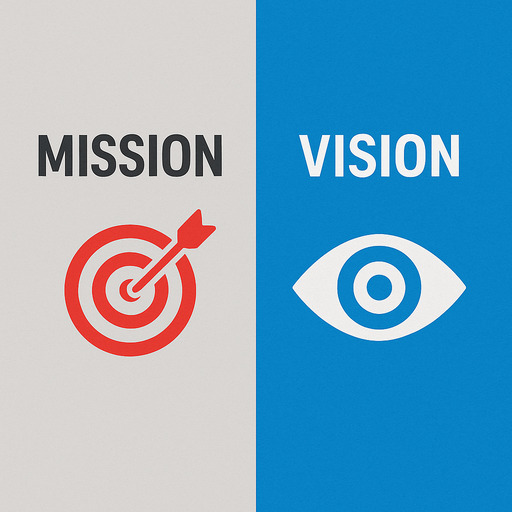 Great strategies start with a compelling mission, a clear and inspiring vision, or both.
Great strategies start with a compelling mission, a clear and inspiring vision, or both.
These are articulated as Mission and/or Vision Statements.
Their role is to provide focus for a strategy, as well as to inspire and motivate.
Mission Statement
A mission statement describes a businesses main purpose. Why was it establish? Why should it continue to exist? How does it improve society? How does it serve its key stakeholders? If the business ceased to exist, what would they lose?
A mission statement should be inspiring. It should give employees a reason to wake up and bring their all to their jobs and to serve people they may never get to meet in person. It should cause stakeholders to root for the success of the business.
If we take the hotel in The Best Exotic Marigold Hotel as an example, its mission statement should not be something bland like:
"To be the best hotel in Jaipur for elderly English people."
but, rather, something more inspiring, like:
"To provide the elderly with a vibrant and caring community in which to relax, socialise and find new meaning in life."
Some examples from well-known organisations:
- BBC: To enrich people's lives with programmes and services that inform, educate and entertain.
- Forbes: To deliver information on the people, ideas and technologies changing the world to our community of affluent business decision-makers.
- Google: To organise the world's information and make it universally accessible and useful.
- Caterpillar: To enable economic growth through infrastructure and energy development, and to provide solutions that support communities and protect the planet.
- Medicins Sans Frontieres: To help people worldwide where the need is greatest, delivering emergency medical aid to people affected by conflict, epidemics, disasters or exclusions from health care.
- Tesla: To accelerate the world's transition to sustainable energy.
To get to a purposeful mission statement, start with what you do, and ask "so what?" three to five times. For example, at StratNavApp.com:
- What we do is we build software for collaborative strategy development and execution.
- So what (1)? More people and organisations will be able to think and act more strategically.
- So what (2)? Those people and organisations will be able to deliver better products and services and create better employment opportunities on a more sustainable basis.
- So what (3)? Those products and services will provide a better quality of life for their customers, and those businesses will provide a better quality of life for their employees.
- StratNavApp.com's mission: To improve quality of life through better strategy development and execution.
On the other hand, I am sure we've all encountered mission statements like this:
We aim to maximise value for our shareholders by focusing on businesses where we have market leadership, a technological edge and a world competitive cost base.
This is uninspiring, self-centered, and sheds no light on what the organisation actually does, for whom, and why it does it. In fact, you couldn't even guess what industry it operates in!
Vision Statement
A vision statement describes what the world will be like once the business has succeeded. It should describe it from the point of view of its key stakeholders. It should paint with words a clear, vivid and inspiring picture of what success will look and feel like.
Vision statements should be future-focused, directional, specific, challenging, unique and inspiring.
Again, using the example of the Best Exotic Marigold Hotel, we should avoid bland statements like
"The best hotel for old people in India."
in favour of something like something like:
"A world in which the elderly are not cast aside but find renewed purpose through friendship and full, meaningful lives."
Some examples from well-known organisations:
- Ford: People working together as a lean, global enterprise to make people's lives better through automotive and mobility leadership"
- Alzheimer's Association: A world without Alzheimer's disease.
- Uber: Smarter transportation with fewer cars and greater access. Transportation that's safer, cheaper, and more reliable; transportation that creates more job opportunities and higher incomes for drivers.
- Caterpillar: A world in which all people's basic needs - such as shelter, clean water, sanitation, food and reliable power - are fulfilled in an environmentally sustainable way and a company that improves the quality of the environment and the communities where we live and work.
- Wikimedia: A world in which every single human being can freely share in the sum of all knowledge.
Do you need both?
Often, businesses don't need both. The mission is to achieve their vision. And their vision is to fulfil their mission. In such cases, either one or the other is enough.
You can see in the fictitious case of The Best Exotic Marigold Hotel above that either a vision or a mission statement would be sufficient. Both would probably be superfluous.
Other times, businesses find that having separate mission and vision statements allows them to more fully express the purpose and ambitions.
It really depends on what works best for each different business.
Tests for vision and mission statement
Here are some tests you can apply to your vision or mission statement to make sure you've got it right.
If you change a few words, would it apply to another business?
For example, if your mission statement is:
To be our customers' preferred supplier of tires.
then you could just as easily change it to:
To be our customers' preferred supplier of hammers.
This mission statement doesn't really tell you anything other than what product you manufacture.
Could the opposite make sense?
In the above example, it would make no sense to say:
To be our customers' least preferred supplier of tires.
If the statement of the opposite (or at least of some alternative) does not make sense, then the statement does not communicate a strategic choice. It's just a statement of the obvious.
Vision and Mission statements versus straplines
Businesses often use typically very short vision or mission statements as straplines for marketing and PR purposes. These may be summary versions of the slightly longer vision or mission statements that drive their strategies. Or they may use them interchangeably.
Many of the vision and mission statements you see on the web are really straplines.
See also:
- Introductory Video Course: Chapter 6: The Strategy Board, Vision and Mission Statements
-
Transforming Vision Statements | The Right Level of Vision for the Right Time
